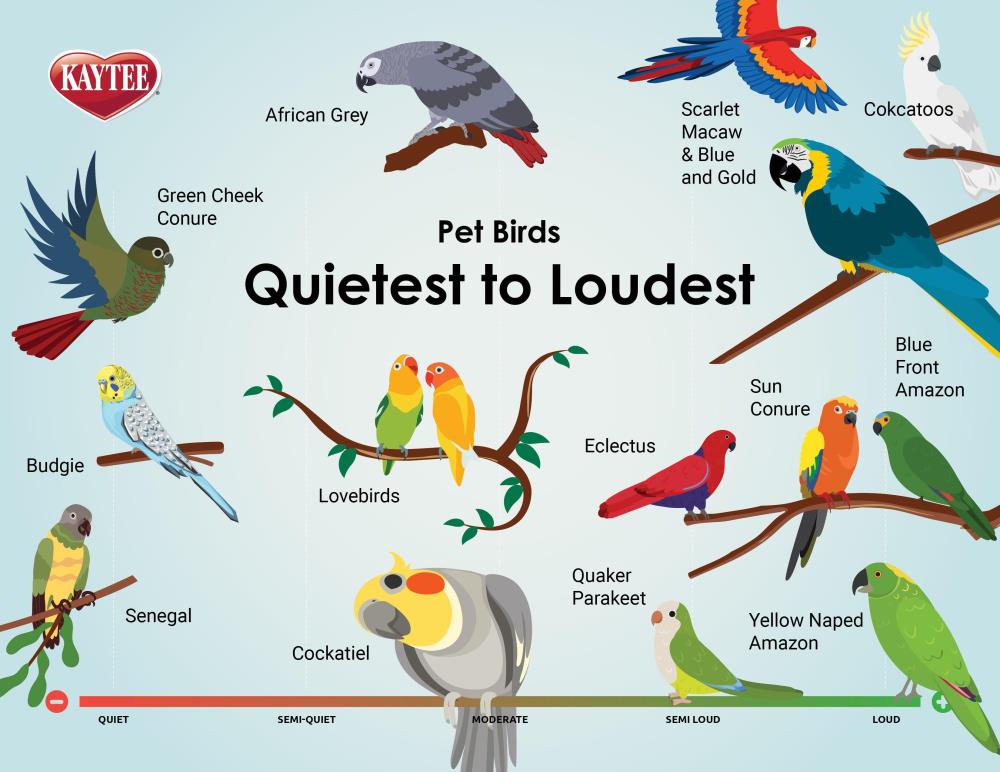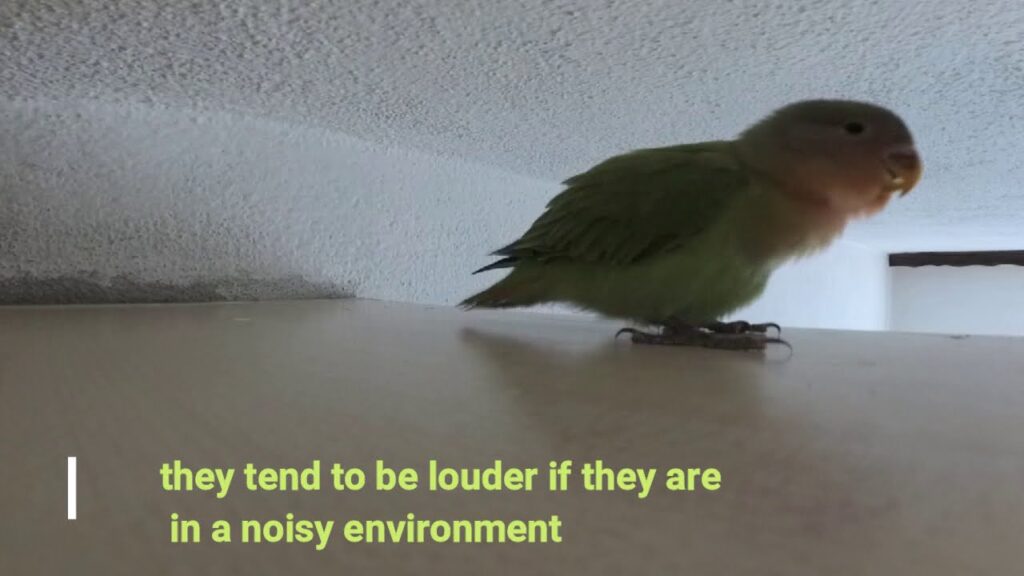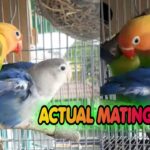Lovebirds can be quite loud, particularly when they vocalize to attract attention or communicate. These small parrots are known for their loud chirps and calls.
Lovebirds are one of the most popular pet birds, adored for their vibrant colors and social nature. Despite their size, they can produce a significant amount of noise, which can be surprising to new owners. They express themselves with a variety of sounds that include chirping, tweeting, and sometimes screeching, especially during the early morning and late afternoon hours, which are their most active times.
While their vocalizations are a natural aspect of their behavior, lovebirds’ loudness can vary among individual birds and the environment they are kept in. Regular interaction and environmental enrichment can sometimes help manage their noise levels, making them a more manageable pet for those concerned about noise.
Are Lovebirds Loud
Lovebirds are famous for their vibrant colors and social personalities. Yet many potential bird owners wonder about their noise level. Understanding the volume and frequency of lovebird vocalizations is key before welcoming one into your home.
The Nature Of Lovebird Vocalizations
Lovebirds express themselves through various chirps, whistles, and squawks. These sounds can signify different emotions or desires, such as calling for attention, expressing happiness, or showing annoyance. Unlike some birds who might sing melodies, lovebirds tend to have a “chatter” that can rise in volume depending on the situation.
Comparing Lovebird Noise To Other Pet Birds
| Bird Species | Noise Level | Noise Frequency |
|---|---|---|
| Lovebirds | Moderate | Often |
| Cockatiels | Low to Moderate | Less Often |
| Parakeets | Low | Very Often |
| Macaws | High | Often |
| Cockatoos | Very High | Often |
Compared to other birds, lovebirds fall into the moderate range for noise level. They are not as loud as larger parrots like Macaws or Cockatoos but can be noisier than Parakeets or Cockatiels. Their vocalizations are frequent throughout the day, which is something to consider for your living environment.

Credit: m.youtube.com
Decoding Lovebird Chatter
Are you curious about what your lovebirds are chirping about? Lovebirds are known for their expressive vocalizations and unique sounds. Decoding their chatter can help you understand and connect with these vibrant little birds on a deeper level. Let’s explore the symphony of noises they make and unravel the mysteries behind their vocal expressions.
Different Types Of Lovebird Noises
Lovebirds create a collection of sounds, each with distinct meanings and purposes. Recognizing these can be crucial for attentive pet owners. Here’s a snapshot of their vocal repertoire:
- Chirps and Peeps: Often a sign of contentment, these sounds can fill your home with cheerful vibes.
- Chattering: This rapid-fire vocalization may indicate a desire for interaction or simply a happy bird.
- Screaming: Loud and impossible to ignore, screams may signal distress, fear, or demands for attention.
- Beak Grinding: A soft sound made usually before sleep, signifying peace and relaxation.
What Lovebirds Are Trying To Say
Deciphering lovebird chatter means tuning into their needs and emotions. Consider these common messages:
| Noise Type | Possible Meaning |
|---|---|
| Chirps and Peeps | Happiness or a call for your attention. |
| Chattering | Desire for social interaction or excitement. |
| Screaming | Stress, anxiety, or a plea for help. |
| Beak Grinding | Comfort and readiness for rest. |
By listening and responding to these sounds, you build a loving bond with your feathered friends, ensuring they feel heard and cared for.
Volume Levels Of Lovebirds
The volume levels of lovebirds can be quite surprising to new bird owners. These small, vibrant parrots are known for their social behavior and loud chirps. To get a true sense of how loud lovebirds can be, we delve into their decibel levels and understand the factors influencing their vocal activity.
Measuring Lovebird Decibels
Decibels (dB) measure sound intensity. Lovebirds typically reach volumes between 50 to 60 dB. This range is equivalent to a normal conversation. It can spike up to 80 dB when they’re exceptionally excited or seeking attention, akin to the noise level of a busy street.
| Activity | Decibel Level |
|---|---|
| Normal Chirping | 50-60 dB |
| Excited/Vocalizing for Attention | Up to 80 dB |
When Are Lovebirds The Loudest?
Lovebirds are known for their loud vocalizations during specific times. Morning and late afternoon are their peak hours for singing and calling. It coincides with their natural wild behavior, where these periods are crucial for foraging and communicating with their flock.
- Early Morning
- Late Afternoon
Environmental factors such as changes in their habitat, the presence of people, or other birds can also affect their volume. They may get louder to express needs or when in distress.

Credit: www.kaytee.com
Factors Influencing Lovebird Noise
Lovebirds are known for their vivid colors and social nature. Their vocalizations can be a delightful symphony or an unexpected alarm clock. Understanding the factors that affect their noise levels is key for any lovebird owner. Here, we explore how different elements can influence the loudness and frequency of lovebird sounds.
Time Of Day And Noise Levels
Noise levels in lovebirds vary with the time of day. Dawn and dusk often see an upsurge in chirping as these active birds communicate more during these hours. Let’s look at how these times impact their vocalizations:
- Morning Chorus: Lovebirds may vocalize vigorously at sunrise to mark their territory and express vitality.
- Evening Calls: As the day winds down, these birds often engage in loud calling to regroup or signal readiness for sleep.
The Impact Of Environment On Lovebird Sounds
The environment plays a crucial role in the vocal behavior of lovebirds. From cage size to the amount of daily interaction, environmental factors can significantly alter the volume and frequency of their sounds. Here, we dig into the specifics:
| Environmental Factor | Impact on Noise Level |
|---|---|
| Cage Size | Spacious cages can lead to more activity and, consequently, more noise. |
| Social Interaction | Regular engagement can result in happier, more vocal lovebirds. |
| Number of Birds | A pair or group is typically noisier as they communicate with each other. |
| Surrounding Activity | Bustling environments can stimulate or stress lovebirds, affecting their noise levels. |
Minimizing Lovebird Noise
If you’ve brought home a pair of vibrant lovebirds, you’re in for a melody of chirps and chatter. But sometimes, their natural music turns into a loud performance. Fear not! There are proven methods to keep the decibels down and enjoy the sweet sounds of your feathered friends without the ruckus. Let’s dive into some trusted techniques for minimizing lovebird noise.
Training Techniques To Reduce Shrieking
Lovebirds might raise their voices for attention or due to boredom. Like children, they require the right guidance to behave. Consistent training can turn the volume down. Here are some steps to encourage your lovebirds to sing sweetly, not shriek.
- Reward quiet behavior: Use treats to reinforce moments when your birds are calm.
- Establish routines: Regular feeding and playtimes provide stability, reducing stress-induced noise.
- Ignore the scream: Don’t rush to the cage at every squawk. This teaches that silence, not noise, brings your attention.
- Teach vocal commands: Use phrases like “Quiet” coupled with rewards to build a language of silence.
Setting Up A Quiet And Comfortable Habitat
A cozy environment is crucial for lovebird serenity. Let’s explore how to create a harmonious home for your chirpy companions.
| Factor | Details | Impact |
|---|---|---|
| Cage placement | Avoid high-traffic areas. Place the cage at eye level in a calm corner. | Reduces startling noises that trigger vocal outbursts. |
| Comfortable size | Choose a cage that’s spacious with room for toys. | Prevents frustration and restlessness, lowering noise levels. |
| Toys and enrichment | Fill the habitat with engaging toys and perches. | Keeps your lovebirds entertained and mentally stimulated. |
| Lighting and temperature | Ensure natural light cycles and a comfortable temperature. | Promotes natural resting behavior and reduces stress-related squawking. |
Remember, a stress-free lovebird is a quiet lovebird. Maintain a tranquil atmosphere in their immediate environment and your birds will chirp happily at a more pleasant volume.

Credit: m.youtube.com
When Noise Might Indicate A Problem
Birds chatter, and lovebirds are no different. They chirp, whistle, and can be quite vocal. But it’s vital to understand when their noise points to potential problems. This section delves into various noises and what they could signify when it comes to your feathered friend’s well-being.
Health Issues And Lovebird Vocals
Occasionally, a lovebird’s squawk could hint at health concerns. Be keen on these vocal cues:
- Raspy or strained chirping suggests respiratory issues.
- Sudden increase in vocalization might signal pain or discomfort.
- Changes in sound quality, like hoarseness, can indicate sickness.
Regular check-ups with an avian vet ensure your lovebird stays in perfect health. Act swiftly at any sign of abnormal noise.
Behavioral Concerns Reflected In Noise
Noise changes can also reflect behavioral issues such as stress or boredom:
| Behavioral Concern | Noise Indicators |
|---|---|
| Stress | Loud, repetitive squawking |
| Boredom | Insistent chirps, noise spikes |
Offer varied toys and interaction to curb boredom-related noise. Notice stress signals? Consider adjusting your lovebird’s environment to provide comfort and security.
The Social Aspect Of Lovebird Sounds
Lovebirds are known not just for their striking colors but also for their vibrant sounds. These petite parrots use a variety of chirps and squawks as a way to socialize. Understanding their sounds sheds light on their social behaviors. Each chirp and whistle plays a crucial part in their interaction with others.
Vocalization In Lovebird Mating And Bonding
When lovebirds are courting, their melodies become a love song. Vocalizations serve as serenades to attract and woo potential mates. Once paired, these sounds strengthen the bond between them. They often mimic each other, which reinforces their connection. A happy lovebird couple might sing together in a duet, showcasing their partnership to the world.
Communicating With Flock Vs. Human Interaction
Lovebirds use distinct sounds when communicating within their flock. These noises help them maintain the flock’s unity and alert others of danger. With humans, lovebirds might develop a different set of sounds or even learn words if trained.
Interaction with their human families can lead to unique vocal behaviors. They may try to communicate their needs or even mimic household noises. Taking time to understand these various sounds can enhance the human-lovebird relationship.
Choosing The Right Bird For You
Are you thinking of bringing a feathered friend into your home? Finding the right pet bird means considering noise levels. Lovebirds are popular pets, but they can be quite vocal. This section of the blog post dives into what to consider when assessing if a lovebird or another type of bird is the perfect match for you.
Assessing Your Tolerance For Noise
Before choosing a lovebird, think about your home environment. Are you sensitive to noise? Do you prefer a quiet space? Birds communicate through sounds and each species has a unique volume level. Lovebirds are known for their loud chirps especially during morning hours and dusk. Creating a checklist of what noise levels are tolerable will guide you in making the best choice for your living space and lifestyle.
Lovebirds Vs. Other Birds: Making An Informed Decision
Each bird species comes with its own noise profile. To make an informed decision, let’s compare lovebirds against other popular birds:
| Bird Type | Sound Level | Chirp Characteristics |
|---|---|---|
| Lovebirds | Medium to high | Frequent, sharp chirps |
| Parakeets | Low to medium | Gentle, melodic chirps |
| Cockatiels | Medium | Whistles and vocalizations |
| African Greys | Low to high | Mimic sounds and words |
Analyze the table above to weigh the differences in noise levels. Lovebirds often rank higher on the noise scale, indicating a potential for more sounds throughout the day. Parakeets, on the other hand, might offer a more toned-down auditory experience. Your choice depends largely on your personal preference for daily background noise and interaction.
Conclusion
Wrapping up, lovebirds can indeed be vocal, but their chatter is often a sign of a healthy, active pet. Understanding their needs and environment helps manage noise levels effectively. Lovebirds offer joyful companionship, singing a testament to their spirited nature.
Embrace their songs; they’re the heartbeats of a vibrant home.
Ryan Everhart is a passionate bird enthusiast and blogger, primarily writing on his website, Avian Whispers. His journey into the world of bird blogging began with a deep interest in parrots, a species that captivated his attention for their intelligence and social behavior. Over time, his content expanded to cover a broader range of bird species, offering insights into bird behavior, care, habitats, and conservation.
Ryan is dedicated to educating his audience, which includes both new bird owners and seasoned enthusiasts. His writing is filled with personal experiences, expert knowledge, and practical advice on bird care. Through Avian Whispers, he aims to foster a deeper appreciation for birds, emphasizing their role in nature and the joys of having them as pets.
Starting with articles focused on parrots, Ryan’s work now encompasses a diverse range of topics such as feeding, training, habitat enrichment, and bird health. His love for birds extends beyond parrots, diving into various avian species. His informative and heartfelt writing reflects his commitment to the well-being of birds and the desire to help others connect with these creatures.
As a growing voice in the bird blogging community, Ryan strives to provide a platform where bird lovers can learn, share experiences, and connect over a shared passion for avian life. His blogs are not only educational but also serve as a reminder of the importance of protecting and nurturing the bond between humans and birds.




